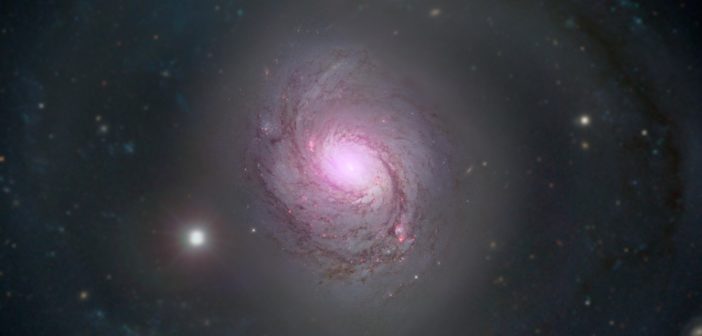Editor’s Note: Astrobites is a graduate-student-run organization that digests astrophysical literature for undergraduate students. As part of the partnership between the AAS and astrobites, we occasionally repost astrobites content here at AAS Nova. We hope you enjoy this post from astrobites; the original can be viewed at astrobites.org.
Title: Solving the Multi-Messenger Puzzle of the AGN-Starburst Composite Galaxy NGC 1068
Authors: Björn Eichmann et al.
First Author’s Institution: Norwegian University for Science and Technology; Ruhr University Bochum, Germany; Ruhr Astroparticle and Plasma Physics Center
Status: Published in ApJ
Pieces of the Multi-Messenger Puzzle
Starburst galaxies have an extremely high rate of star formation (between 10 and 300 times the mass of our Sun per year, while the Milky Way forms new stars at a rate of about 2 masses of the Sun per year)1 and supernova explosions, making them an incredibly interesting source for astronomers studying the evolution of stars and galaxies. But starburst galaxies can also be intriguing multi-messenger sources because of their emission of high-energy gamma rays, indicating that these sources can accelerate particles up to extremely high energies.
When high-energy particles (usually called cosmic rays) are accelerated to extreme energies, they can smash into each other, producing high-energy gamma rays and neutrinos. These messengers (cosmic rays, photons, and neutrinos) can give us immense amounts of information about their sources. Today’s authors delve into the starburst galaxy NGC 1068, which also has an active galactic nucleus at its center, making it an interesting source for multi-messenger study. The authors describe their model for emission of gamma rays and neutrinos from NGC 1068 and compare the model to observations from multiple telescopes (VLA, ALMA, Fermi-LAT, MAGIC, and IceCube).
What Does a Starburst Galaxy Look Like?
Figure 1 shows a sketch of the structure of NGC 1068, including its active galactic nucleus.

Figure 1: A sketch of the active galactic nucleus in a starburst galaxy (not to scale), highlighting different regions for the model. The active galactic nucleus can be seen at the center, surrounded by the corona (yellow, Zone I) and its accretion disk. At the edges, just past the torus, is the starburst region (purple with stars, Zone II). These show the two zones for emission in the model discussed in this research article. [Eichmann et al. 2022]
Also on this sketch we can see the three different types of messengers that are being emitted by different regions. Cosmic rays (labeled CR) are shown in red, and they can be seen to meander due to the presence of magnetic fields acting on these charged particles. Photons can be seen in sine-wave-like lines, with the frequency indicated by the frequency of the sine wave. This article focuses on the highest energy photons, gamma rays, here labeled in pink, and other photons are labeled in black. However, NGC 1068 has also been observed with other frequencies of photons, so the authors incorporate radio and infrared data for NGC 1068 into the fit.
The green arrows represent neutrinos, which are being produced in cosmic ray interactions. Because neutrinos rarely interact, they travel away from the source virtually unimpeded.
So, what do we see when we look for gamma rays and neutrinos from this source? The authors describe emission from two main zones of NGC 1068:
Zone 1: Active galactic nucleus corona: here, particles are accelerated by the active galactic nucleus.
Zone 2: Starburst region: where nearby supernovae and star formation happens.
Only by using both of these regions, not a model only for a single region as has been done in previous works, can these authors explain both the photons and neutrinos seen from NGC 1068.
What Can This Model Say About NGC 1068?
After fitting their model using radio, infrared, gamma-ray and neutrino observations of NGC 1068, the authors plot the result of those fits and the total contributions in gamma rays and neutrinos. This plot can be seen in Figure 2.

Figure 2: This plot shows the predictions of photon and neutrino energy fluxes from this model across many orders of magnitudes in energy. The lines described by the legend on the right side of the figure show different parts of the model, with all red lines for emission from the corona (Zone I), all blue lines emission from the starburst region (Zone II), and black lines for total contributions of photons (solid black) and neutrinos (black with green outline). Overlaid on this are measurements from several radio (VLA, ALMA), gamma-ray (4FGL, MAGIC), and neutrino (IceCube) telescopes (legend on the top left of this plot). [Eichmann et al. 2022]
The model is able to explain all of the data across multiple wavelengths and messengers, with some small deviations. The authors see that the gamma-ray emission at the highest energies (above 1 GeV) comes from the starburst region (Zone II), while the high-energy neutrinos (around 1 TeV) come from the active galactic nucleus corona (Zone I). By using both zones in the model, all of the emission in both neutrinos and gamma rays can be explained by this model.
This is the first multi-messenger fit including photons over a wide range of energies and neutrinos for an active galactic nucleus–starburst composite galaxy. The entire model works well to explain all of the observed data seen in photons and neutrinos, making it an exciting evolution of astronomers’ understanding of NGC 1068, and other active galactic nucleus–starburst composite galaxies.
1 Source: Schneider, Peter. Extragalactic Astronomy and Cosmology: An Introduction. Berlin, Heidelberg: Springer Berlin Heidelberg, 2015.
Disclaimer: The author of this astrobite works with article coauthor Julia Becker Tjus but was not involved in this research.
Original astrobite edited by Pratik Gandhi.
About the author, Jessie Thwaites:
Jessie is a PhD student at the Wisconsin IceCube Particle Astrophysics Center at the University of Wisconsin-Madison. They study possible astrophysical sources for high energy neutrinos through multimessenger astrophysics. Outside of physics, they play horn and enjoy spending time outdoors, especially skiing and biking.
